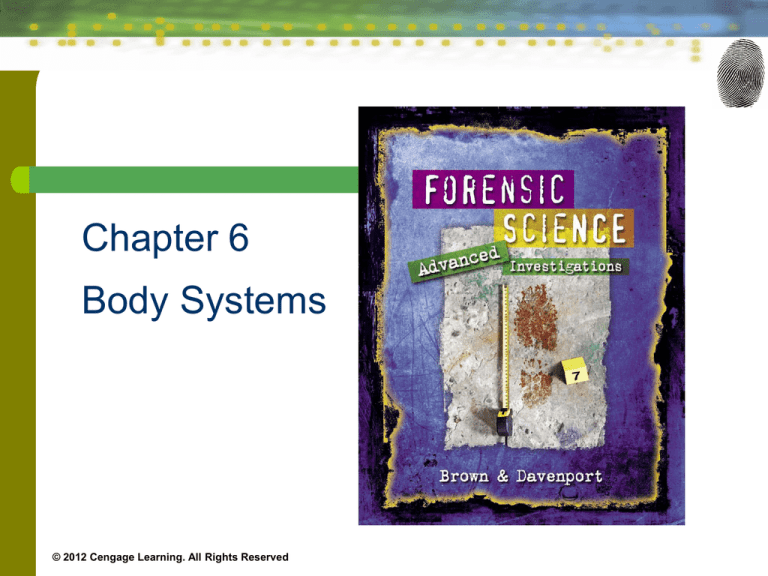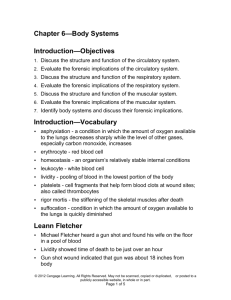
Chapter 6
Body Systems
© 2012 Cengage Learning. All Rights Reserved
Introduction—Objectives
1. Discuss the structure and function of the
circulatory system.
2. Evaluate the forensic implications of the
circulatory system.
3. Discuss the structure and function of the
respiratory system.
4. Evaluate the forensic implications of the
respiratory system.
2
Forensic Science II: Body Systems, Chapter 6
© 2012 Cengage Learning. All Rights Reserved
Introduction—Objectives
5. Discuss the structure and function of the
muscular system.
6. Evaluate the forensic implications of the
muscular system.
7. Identify body systems and discuss their
forensic implications.
3
Forensic Science II: Body Systems, Chapter 6
© 2012 Cengage Learning. All Rights Reserved
Introduction—Vocabulary
o
o
o
o
4
asphyxiation - a condition in which the amount of
oxygen available to the lungs decreases sharply
while the level of other gases, especially carbon
monoxide, increases
erythrocyte - red blood cell
homeostasis - an organism’s relatively stable
internal conditions
leukocyte - white blood cell
Forensic Science II: Body Systems, Chapter 6
© 2012 Cengage Learning. All Rights Reserved
Introduction—Vocabulary
o
o
o
o
5
lividity - pooling of blood in the lowest portion of the
body
platelets - cell fragments that help form blood clots
at wound sites; also called thrombocytes
rigor mortis - the stiffening of the skeletal muscles
after death
suffocation - condition in which the amount of
oxygen available to the lungs is quickly diminished
Forensic Science II: Body Systems, Chapter 6
© 2012 Cengage Learning. All Rights Reserved
Leann Fletcher
o
o
o
o
6
Michael Fletcher heard a gun shot and found
his wife on the floor in a pool of blood
Lividity showed time of death to be just over
an hour
Gun shot wound indicated that gun was
about 18 inches from body
Michael was arrested, charged, and
convicted of second-degree murder
Forensic Science II: Body Systems, Chapter 6
© 2012 Cengage Learning. All Rights Reserved
Introduction
o
o
o
7
Anatomy—the study of the structure of the
human body
Physiology—the study of the function of the
body systems
Homeostasis—a stable internal environment
Forensic Science II: Body Systems, Chapter 6
© 2012 Cengage Learning. All Rights Reserved
The Circulatory System (Obj 6.1, 6.2)
o
o
8
Systemic—the heart pumps oxygenated
blood through arteries to body cells
Pulmonary—the heart pumps the
deoxygenated blood, carbon dioxide and
other wastes to the lungs
Forensic Science II: Body Systems, Chapter 6
© 2012 Cengage Learning. All Rights Reserved
9
Forensic Science II: Body Systems, Chapter 6
© 2012 Cengage Learning. All Rights Reserved
Properties of Blood
o
o
o
o
10
Red Blood Cells
White Blood Cells
Platelets
Plasma
Forensic Science II: Body Systems, Chapter 6
© 2012 Cengage Learning. All Rights Reserved
Red Blood Cells
o
o
o
o
11
Also called erythrocytes
Carries oxygen throughout the body
Concave shape creates
a large, efficient surface
area
Hemoglobin—a protein
that binds oxygen for
transport
Forensic Science II: Body Systems, Chapter 6
© 2012 Cengage Learning. All Rights Reserved
White Blood Cells
o
o
12
Also called leukocytes
Protects the body against infection and fight
viruses and bacteria.
Forensic Science II: Body Systems, Chapter 6
© 2012 Cengage Learning. All Rights Reserved
Platelets
o
o
o
13
Also called thrombocytes
Helps form blood clots that act as a plug at
open wounds
These clots
become
scabs
when
hardened
Forensic Science II: Body Systems, Chapter 6
© 2012 Cengage Learning. All Rights Reserved
Plasma
o
o
o
14
The liquid potion of blood—92% water
Blood cells and platelets are suspended in
plasma
Transports important nutrients, vitamins and
gases
Forensic Science II: Body Systems, Chapter 6
© 2012 Cengage Learning. All Rights Reserved
Human Heart
o
o
15
Atria—upper
chamber
Ventricles—lower
chamber
Forensic Science II: Body Systems, Chapter 6
© 2012 Cengage Learning. All Rights Reserved
Forensic Implications of the
Circulatory System
o
o
o
o
o
o
16
Blood type—class characteristic
DNA—individual characteristic
Blood—biological evidence
Hemastix®—a presumptive test for blood
Luminol—another presumptive test
Collect samples of blood evidence
Forensic Science II: Body Systems, Chapter 6
© 2012 Cengage Learning. All Rights Reserved
Lividity
o
o
Lividity—the pooling of blood in the direction
of gravity
Livor mortis—
•
•
17
the change in color
caused by lividity
Bluish purple or
reddish purple
Forensic Science II: Body Systems, Chapter 6
© 2012 Cengage Learning. All Rights Reserved
Petechiae
o
o
18
Often occurs when a limb is in a hanging
position
Small red dots underneath the surface of the
skin
Forensic Science II: Body Systems, Chapter 6
© 2012 Cengage Learning. All Rights Reserved
Blood Splatters
19
Forensic Science II: Body Systems, Chapter 6
© 2012 Cengage Learning. All Rights Reserved
The Respiratory System (Obj 6.3, 6.4)
20
Forensic Science II: Body Systems, Chapter 6
© 2012 Cengage Learning. All Rights Reserved
The Respiratory System—Structures
21
Forensic Science II: Body Systems, Chapter 6
© 2012 Cengage Learning. All Rights Reserved
Forensic Implications of the
Respiratory System
o
o
o
o
22
Cellular respiration
6O2 + C6H12O6 6CO2 + 6H2O + Energy
C6H12O6 is glucose which comes from food
Oxygen from the air combines with glucose to create
energy for the cells in your body
Asphyxiation—when the available oxygen
decreases sharply while the level of toxic gases
increases
Forensic Science II: Body Systems, Chapter 6
© 2012 Cengage Learning. All Rights Reserved
The Muscular System (Obj 6.5, 6.6)
23
Forensic Science II: Body Systems, Chapter 6
© 2012 Cengage Learning. All Rights Reserved
Forensic Importance of the
Muscular System
o
o
o
o
24
Actin and myosin—two proteins that form
fibers within muscles
Muscles contract when myosin attaches to
the actin, forming a bridge
Lack of oxygen after death prevent muscles
from relaxing
Rigor mortis—the process in which the
muscles of a body begin to stiffen
Forensic Science II: Body Systems, Chapter 6
© 2012 Cengage Learning. All Rights Reserved
The Forensic Implications of
Other Body Systems (Obj 6.7)
25
Forensic Science II: Body Systems, Chapter 6
© 2012 Cengage Learning. All Rights Reserved
The Forensic Implications of
Other Body Systems
26
Forensic Science II: Body Systems, Chapter 6
© 2012 Cengage Learning. All Rights Reserved
The Forensic Implications of
Other Body Systems
27
Forensic Science II: Body Systems, Chapter 6
© 2012 Cengage Learning. All Rights Reserved
The Forensic Implications of
Other Body Systems
28
Forensic Science II: Body Systems, Chapter 6
© 2012 Cengage Learning. All Rights Reserved
Chapter Summary
o
o
Each body system can offer clues regarding the
events that led up to or occurred during the crime.
The circulatory system
•
•
o
The primary role of blood is to transport oxygen to
the cells and wastes from them. Components are:
•
•
•
•
29
systemic circulation
pulmonary circulation
red blood cells,
white blood cells,
platelets, and
plasma.
Forensic Science II: Body Systems, Chapter 6
© 2012 Cengage Learning. All Rights Reserved
Chapter Summary
o
o
o
o
30
Gas exchange occurs in the alveoli of the lungs.
Capillaries, very small blood vessels surrounding the
alveoli, transport oxygen into the body and carbon
dioxide out of the body.
Lividity occurs when blood pools in the lowest part of
the body after a person dies. Lividity provides clues
about the time and the position of the body at death.
The primary function of the respiratory system is to
remove gaseous wastes from the blood and to
transport oxygen.
Forensic Science II: Body Systems, Chapter 6
© 2012 Cengage Learning. All Rights Reserved
Chapter Summary
o
o
o
o
31
The respiratory tract is divided into upper and lower.
Asphyxia occurs when the amount of available
oxygen decreases while toxic gases increase.
Suffocation is a form of asphyxia that occurs when
the amount of available oxygen decreases.
Rigor mortis is the process where the muscles of the
body begin to stiffen after death. Rigor begins within
two hours after death and can last from 24 to 48
hours.
Forensic Science II: Body Systems, Chapter 6
© 2012 Cengage Learning. All Rights Reserved








